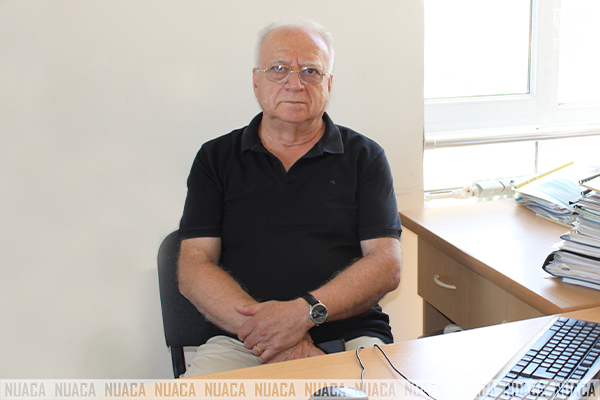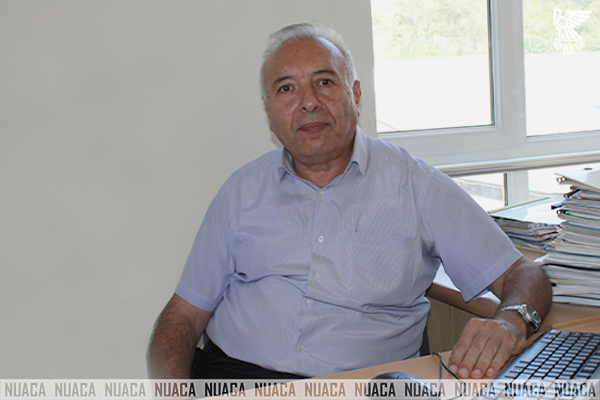The origin of Architectural education in Armenia derives from 1921 within the Technical Faculty of National University and then well-established according to following chronology:
1930-1933- Architectural education existed in the complex of Construction Institute.
1933-1991- the module of Architecture was the part of Architecture and Construction Department with its long and productive existence within Yerevan Polytechnic Institute. The specialized department of Architecture was created by the efforts of respectable architect Nikoghayos Buniatyan heading the Chair only 2 years (till 1938). Later all modules related to this specialization were formed and taught tying theory with practical creative activities and inspiring with the idea of absorbing the rich traditions of Architecture and making them meaningful in the spirit of Armenian studies. From 1938 to 1944 the head of Chair was Harutyun Zaqyan with his huge contribution in the sphere of construction activities and organization of Yerevan Polytechnic Institute.
Varazdat Harutunyan was the head of Chair from 1945 to 1990 and later 2 new chairs on “Architecture of Industrial and Civil Buildings” (1967) and “Drawing and Sculpture” (1975) were created. In 1990 the Yerevan State University of Architecture and Construction was created and hence the Chair of architecture was divided into different specialized chairs of the “Theory, History of Architecture and Restoration of Monuments” (head of Chair was doctor of Architecture, professor Arshavir Toramanyan), “Urban Construction” and “Architectural Design”.
Since 1993 the head of Chair is the doctor of Architecture, professor, reputable architect of Armenia and at the same time vice-rector on scientific affairs of the university Yuri Safaryan. Vice-heads of the Chair were doctor of Architecture, docent Marietta Gasparyan, doctor of Architecture, professor Garnik Shakhkyan and doctor of Architecture, professor David Qertmenjyan.
Specialists are trained in 2 directions: Architecture and Design of Architectural Environment. In the teaching activities of faculty the main priority is their scientific research and the doctoral team of the Chair became the core of 029 specialist council of the Higher Attestation Commission of the Republic of Armenia for the defence of doctoral and PhD theses.
The directions of the Chair’s scientific research are the theoretic study of problems existing in world and Armenian Architecture, analysis of development prospects of the sphere, creation of scientific grounds for the resettlement, study of complex historical and architectural issues on Armenian and international scale, scientific and methodological concretization of scientific basics and the opitmalization of methodological issues on the specialized mastery achievement for architects especially in the spheres of restoration of architectural moments and reconstruction of environment.
Well-known and reputable professionals contributed to the establishment and success of the Chair of “Theory, History of Architecture and Restoration of Monuments”. Among them were the academician of the National Academy of Sciences Varazdat Harutyunyan, Dr. Prof. of Architecture Edmond Tigranyan, Dr. Prof. of Architecture and corresponding member Oleg Vardanyan, Dr. Prof. of Architecture, corresponding member and distinguished architect Martin Mikayelyan, candidates or docents of Architecture Levon Zorian, Shmavon Azatyan, Sahak Qeshishyan, academician Sergey Karapetyan, professor, academician and the distinguished architect of Armenia Spartak Khachikyan. As well as associate professors, associate members, PhD and docents Tigran Barseghyan, Samvel Danielyan, Taguhi Khachatryan, Arshaluys Meliqsetyan, Vahagn Grigoryan, candidate of Arts Hasmik Philiposyan, candidate of archeology Hakob Simonyan, lecturers Ruben Azatyan, Simon Barseghyan, Levon Igityan, Arshak Ghazaryan, Ashot Manasyan, Suren Melik-Qaramyan, Tigran Sahakyan, Sargis Sardaryan, Petros Soghomonyan, Garnik Stepanyan and others.
Currently the Chair has 6 doctor-professors, 2 doctor-docents of science, 2 professors, 4 candidate docents, 4 docents, 15 candidate-assistants, 5 assistants, 7 lecturers, 3 laboratory workers as well as 1 doctorate and 14 graduate students; the 3 of them are full-time and 8 part-time students, and 3 of them are applicants.





























